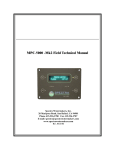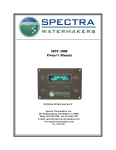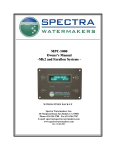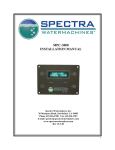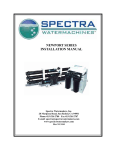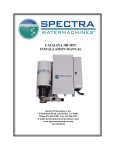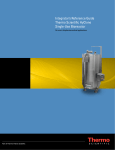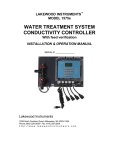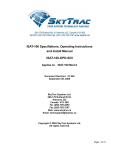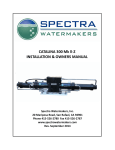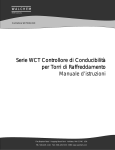Download MPC-3000 Field Technical Manual
Transcript
MPC-3000 Field Technical Manual Spectra Watermakers, Inc. 20 Mariposa Road, San Rafael, CA 94901 Phone 415-526-2780 Fax 415-526-2787 E-mail: [email protected] www.spectrawatermakers.com Rev. 08-11-05 2 Spectra Watermakers MPC-3000 Field Technical Manual Revision A25 08-16-05 This manual is intended for use by Spectra Watermakers Field Service Technicians as a technical reference document. Its goal is to contain the necessary information as to be of value to field technicians addressing installation of hardware and software, system configuration, and system troubleshooting. In the event that necessary information is not contained in this document, call Spectra Watermakers at (415) 526-2780. Table of Contents: Software Installation……………………………………………………………………………. 5 Software Port Settings ………………………………………………………………………….. 7 Software Features ………………………………………………………………………………. 11 Computer Settings ……………………………………………………………………………… 13 Rotor Flow Meter Operation …………………………………………………………………… 14 Salinity Probe Calibration ……………………………………………………………………… 15 Upgrades ……………………………………………………………………………………….. 16 Prefilter Notes ………………………………………………………………………………….. 17 Tank Switch Operation and Installation ……………………………………………………….. 18 MPC-3000 Operation Guide (Gulfstream mode) ……………………………………………….19 MPC-3000 Operation Guide (Monterey mode) ………………………………………………... 29 3 4 Software Installation from CD: 1) Insert the Spectra Watermakers CD-ROM into the computer’s CD-ROM drive. 2) Using “My Computer” or Windows Explorer, locate and double-click the “setup.exe” file on the CDROM drive. This will begin the installation process. Follow the on-screen instructions. 3) When the software is installed, it will open from the “Start → Programs” menu 4) Before using the software, your MPC-3000 circuit board must be connected to your computer’s COM port using a standard RS-232 serial cable (NO crossovers on cable). 12V or 24V DC power must be applied to the MPC-3000 board, and the board must be on before the software can communicate with it. The software may not run if these steps are not taken. You will get an error message if there is a COM port conflict. 5) If you have no serial port available, you may purchase a USB-to-serial port adapter. Once the software has been installed, open the directory where it was installed, locate and double-click the “spectra.exe” file to run the program. To reset the COM port, follow the directions beginning on page 5. When the software is opened and the watermaker is connected, you will see this window: 5 6 MPC Software Port Settings Start → Settings → Control Panel → System Choose the “Hardware” tab and click on “Device Manager” 7 Open the “Ports” group Ports → Communications Port The above picture shows the alternative USB-to-serial device in the device manager. It’s located under the same group of ports. The way to setup the COM port will be the same as it is to set the serial-to-serial communication port, which is as follows: Right-click on the correct port for your system and choose Properties. Click on Port Settings → Advanced. 8 For serial-to-serial communication, select COM port 2, 3, or 4 For USB-to-serial communication, select COM port 2, 3, or 4, but make sure that the assigned port number will not duplicate your serial port number if your computer has a serial port. Click OK and close all the windows. Open Windows Explorer. If you don’t know how to do this, right-click on Start and choose “Explore”. Navigate to your “Program Files” folder. Find the “Spectra” folder. Inside, find and open “spectra.ini”. 9 Change the number on the first row to be the same as the number of the COM port you chose, then save and close the file. Now we’re ready to run the software. Start → Programs → Spectra The software should now run properly. 10 Software Features: 1) Show LCD Data: Clicking on this field will change the settings window to allow you to change what is displayed on the control Panel. This feature can allow you to customize the display for another language if desired. Select the line to change, enter a new caption for that line, and hit change. There are limits to how many characters are allowed. Contact the factory before making changes in this window. 2) Port: Allows you to select which COM port on your computer will communicate with the MPC-3000 board via RS-232 serial cable. 3) Inlet Pressure: Displays real-time system pressure at the prefilter inlet. 4) Diff Pressure: Displays real-time pressure differential across the two prefilters. 5) Hours: Displays total hours the MPC-3000 has been run. 6) Manual, Auto, Flush, A.Flush, Timer: These are simply display lights to show which mode the MPC-3000 is currently in. The timer will display any countdown time for the current mode. 7) Rate GPH: Real-time meter showing gallons or liters per-hour product. 8) Salinity: Real-time meter showing salinity measurement of product water in parts-per-million. 9) Fresh Water Tank 1, Fresh Water Tank 2, Sea Strainer: Display lights to indicate state of tank switches and sea strainer condition. 10) Pump1, Pump2, Dvlv, Fvlv, Pvlv, Aux1, Aux2, Aux3, Ster: Display lights to indicate output states of the MPC board. 11) Battery Voltage: Displays current DC voltage applied to the MPC board. 12) Rotor Flow Meter: Check this box if a rotor flow meter is to be used. Refer to “Rotor Flow Meter Operation” section later in this manual. 13) Metric: Check box to change display units of measurement from English to metric. (Can also be accomplished by pressing and holding “Alarm/Disp” on the LCD display for 5 seconds.) 14) PPM Threshold: Default at 500 ppm, Sets the reject salinity level of product water. This is currently factory set at 750 PPM. (Above 750ppm product is rejected, below 750ppm it is accepted and diverted to holding tank). 15) PSI Max Pressure: Used to set the maximum allowable system pressure, measured at prefilters. Typically 150psi for Newport400 systems, and 250psi for Monterey/1000 gallon systems. 16) PSI DIF. Pressure: Used to set the differential cutoff pressure; the two pressure sensors at the prefilter are used to measure any difference in pressure between the two prefilters, possibly caused by a dirty filter. Differential Cutoff will stop system and sound alarm if differential pressure exceeds set maximum. Typically set to 10 psi. 11 17) Displacement: A percentage value that matches the percentage value of the Clark Pump being used. Equivalent to the size of the rod inside the Clark Pump; if, for example, you were using a 10% pump, then 10% of all water entering the Clark Pump would be “displaced”, or squeezed through the membrane into product water. Since the size of the rod is known, we can now use the stroke sensor to count the cycles of the Clark Pump, and get an accurate reading of GPH product output. 18) Transducer 1 & 2 Zero Calibration: Used to calibrate the pressure transducers if necessary. 19) 250 PSI Transducers: Originally meant as a display light rather than a check box, this field is not normally used or necessary. Use PSI MAX pressure instead. 20) Differential Calibration: Used in the event that a differential pressure is noticed, perhaps even at zero pressure, yet the pressure transducers appear to be in calibration, differential calibration can be used to offset the reading and resume a correct zero state. 21) Flush Duration: In minutes, the time it will take to complete one flush cycle. Typically 5 minutes, or longer for systems with long membranes or more elaborate systems. 22) Flush Period: In hours, the period of time between flushes, while in unattended storage mode. Typically 120 hours. (5 days) 23) Pump On/Off Time: In seconds, the amount of time the pump will be turned on or off during a fresh water flush mode. Meant to give the charcoal filter time to deal with the onrush of water, some systems will have the pump off time set to 0, effectively turning the pump continuously on during fresh water flush. Consult the “Computer Settings” chapter later in this manual to match your specific system. 24) Change Hours: Just in case you want to roll back your odometer. 25) READ and WRITE: Any time a change is made to your settings you must WRITE it to the microprocessor. It is recommended you follow up by pressing READ to ensure your changes took place. Abbreviations: DVlv: Diversion Valve FVlv: Fresh Water Flush Valve PVlv: Priming Valve Aux1: Auxiliary Contact One: The following pages describe the function of each of the buttons and fields in the Spectra MPC-3000 programming window. 12 Computer Settings: These are typical computer settings for standard Spectra systems. Unless otherwise specified, all other values remain the default Newport 400 values. Change the settings in the programming boxes as shown for each model. SETTINGS FOR UNITS WITH STROKE SENSORS Ventura: Max Pressure: 125 Displacement: 7% Flush Duration: 3 Pump On Time: 3 Pump Off Time: 0 Catalina 300 Max Pressure: 125 Displacement: 10% Flush Duration: 5 Pump On time: 3 Pump off time:6 Newport 400: (12 and 24v DC) Max pressure: 150 Displacement: 10% Flush Duration: 6 Pump On Time: 3 Pump Off Time: 0 Newport 400 AC Version: Max Pressure: 150 Displacement: 10% Flush Duration: 6 Pump On Time: 3 Pump Off Time: 0 380 Modular Kit: Max Pressure: 140 Displacement: 10% Flush Duration: 4 Pump On Time: 3 Pump Off Time: 0 Newport 700: Max Pressure: 200 Displacement: 12.5% Flush Duration: 7 Pump On Time: 3 Pump Off Time: 0 Newport 1000 or Monterey: Max Pressure: 250 Displacement: 18.5% Flush Duration: 8 Pump On Time: 3 Pump Off Time: 0 REV 4-01-04 13 Rotor Flow Meter: We are currently shipping our watermakers with Gems brand rotor flow meters. A rotor flow meter is a pinwheel device with a hall-effect sensor built in, installed in line with product water output from the reverse osmosis (RO) membrane. When water passes through the meter, it spins the pinwheel; the hall-effect sensor picks up the motions of the pinwheel and sends the frequency of the spinning pinwheel to the MPC board. The MPC board then calculates, based on a “meter constant”, the gallon-per-minute output of product water, thereby eliminating the need for a stroke sensor. The rotor flow meter uses the same three terminals on the MPC-3000 circuit board as the stroke sensor. When programming a watermaker with a rotor flow meter, the “Rotor Flow Meter” check box must be checked. The “Displacement” field will then read a default constant which can be adjusted up or down to calibrate the product flow reading on the display. Start with a setting of 14,000. Run the watermaker with the product going into a measured container instead of the tank and time the product flow. Adjust the roto flow constant up or down until the display reads the same as the actual measured flow. 14 Salinity Probe Calibration: Salinity is a measurement of total dissolved solids in liquid (TDS). These solids will conduct electricity to varying degrees. A special probe is used, with two electrical contacts in it, to determine the resistance to the flow of electricity in the liquid. In the Spectra Watermakers’ systems, the salinity probe is located just before the diversion valve, at the output of the RO membrane. This way we can look at the salinity level of the product water before deciding to either reject the water or accept it and divert it into the holding tank. The salinity level in parts-per-million (PPM) can be seen either through the salinity meter in the software or by adding a jumper to the MPC board in the “calibrate” position. The salinity can then be seen on the LCD display (rather than a bar graph). After adding the jumper, it may be necessary to cycle through the different LCD displays until the display reads “Salinity.” Procedure: 1. Locate the calibrate jumper location on the MPC-3000 Board. Jump the terminals. 2. Start the system. After the salinity stabilizes, test the product water with a calibrated hand held tester. 3. Locate the MPC calibration trimmer potentiometer on the board below the salinity probe jack. Adjust until the display PPM matches the PPM reading from the hand held salinity monitor. Turning the trim pot clockwise will lower the salinity reading, and counter-clockwise will raise it. 4. Shut the system down and disconnect the jumper on the MPC board. If a hand held meter is not available, you can remove the probe and dip it into a known calibrated solution. This can be obtained from Spectra. 15 Upgrades: The version of microprocessor software used in the control is shown on the display whenever the watermaker is in standby mode (powered up but not in run or auto flush mode. It is possible to upgrade Newport series watermakers through the different versions of software/firmware. Outlined below are some of the requirements and procedures necessary for upgrade. NOTE: It is very important to use the correct version of programming software for the version of microprocessor software. B29 The current software version. It fixed a pressure sensor calibration reset on start up error present in A28 and A29 if you are experiencing nuisance shutdowns from “High Pressure” or “Service Prefilter” alarms on systems using A28 or A29. A29 Modified salinity temperature calibration circuit A28 Removed system stalled shutdown during purge A27 Fixed a glitch in the metric pressure reading display A26 Added rotor flow A25 Adds automatic pressure relief control for the watermachine series and fixes a few small glitches. Uses version 1.08 software A24 Minor fixes from A23 include enabling the Start/Stop button to halt the system in ALL modes of operation, and to display when the tanks are full when the system has shut down, if applicable. Software for A24 is version 1.08, upgrading to A24 is a microprocessor change. A23 is a test revision firmware. Features added include voltage cutoff spread increase, Auto-fill mode, and some display improvements. A23 is quite functional, but a few improvements have been made to make the system more user-friendly. Software for A23 is version 1.06. Upgrading to A23 is a microprocessor change. A21 was the standard working firmware for a while, with no-frills, solid, working code. Some problems that might be encountered with A21 are that the high and low voltage cutoffs are not spread out far enough– you are more likely to see high and low voltage alarm problems because of it. Software for A21 is version 1.03. Upgrading from A21 to A23 is a microprocessor change. A19 to A21 require a minor wiring change in 12 and 24 volt systems. When upgrading from A19 software, call the factory for instructions. Upgrading an A19 1000gal/Monterey/AC system to A21/A23 requires only a new microprocessor- no wiring changes are necessary. 16 Prefilter Notes: At some point around mid 2002, it was realized that the silkscreen on the PCB for the prefilter “inlet” and “outlet” connections was wrong. A number of systems went out with the cables reversed. To test this, remove one of the cables at the pressure sensor and start the system. If the system stops and a “Check Prefilter” alarm is displayed, then the cable that is still connected should be located at the inlet side. If the system continues to run, then the cable that is connected is the outlet cable and should be located on the outlet side of the filter port. Inlet side Outlet side Notice silkscreen is reversed Inlet side Outlet side 17 Tank Switch Installation and Operation: There are two sets of terminals on the MPC-3000 PCB that can be used in four different configurations to automatically start and stop the watermaker, or to automatically stop the watermaker when the tank(s) are full without the “Auto Start” feature. These terminals are on the green ten-pin connector and are labeled “Float Switch 1” and “Float Switch 2.” Float Switch 1 is the tank full switch, and Float Switch 2 is the tank empty switch. If the unit is wired for both auto-start and auto-stop, it can be put into auto-fill mode by pushing and holding the “Auto Run” switch on the MPC-3000 display. In this mode, the watermaker will start whenever the water level drops below the tank empty switch, thus opening it (breaking the circuit). When the tank fills up and both the tank full and tank empty switches have remained closed for two minutes, the watermaker will shut down and flush itself. The water maker will then start back up when the water level drops below the tank empty switch and it remains open for 2 minutes. This configuration allows for completely automatic operation. If the watermaker does not need to start up within five days, it will automatically do a fresh water flush. Auto-fill mode can be ended by pushing the “Stop” button or the “Auto Flush” button. If the watermaker is in auto-run mode it can be put into auto-fill mode without stopping it by holding down the “Auto Run” button. If the owner prefers to install the automatic shutoff feature without the automatic start up option, only the tank full switch is used. A jumper must be placed between the tank empty terminals (Float Switch 2) in place of the tank empty switch, because the watermaker will only shut down if both sets of terminals are closed. To use this mode, the watermaker must be started up with the “Stop/Start” button or the “Auto Run” button. After the unit starts up, press and hold the “Auto Run” button until the display reads “Auto Fill Mode”. The watermaker will fill the tank and automatically enter auto-flush mode. It is possible to use the auto-fill feature with two tanks. A double-throw electrical switch must be installed in a convenient location. If only the single tank full switch is installed in each tank, connect the wire from Float Switch 1, terminal 1 to the common on the switch and run separate wires from the switch to each tank switch. The second wires can both be run to Float Switch 1, terminal 2. If you are using two switches in each tank, you will need a double-pole, doublethrow switch. 18 Spectra MPC-3000 Operation Guide Gulfstream Mode This document is a basic outline of MPC-3000 mode operations. It details what is seen on the LCD display, what outputs are active during run-time, and how the different modes work together. Gulfstream Mode is used on watermakers having two feed pumps Gulfstream & Santa Cruz). The MPC-3000 will be in Gulfstream mode if the JP2 pins on the MPC-3000 printed circuit board are jumped together. In this mode the Watermaker has two RUN modes. When the system is started it will be in RUN HIGH Mode and both feed pumps will Run and the watermaker will make 380 gallons per day. If the Stop button is held down for five seconds the watermaker will enter RUN LOW mode, Pump One, will stop and the unit will make 200 gpd. 19 20 Power On Power On OPEN PRESSURE RELIEF VALVE NOW Initial Startup Purge Mode Auto Run STARTING or 2:00 Pump2, Pvlv, Aux1, Aux2 When 30 seconds remaining, Pump2 Off, Pump1 On Start Stop Purging All Off, Aux1 On PURGING STORAGE SOLUTION 18:30 Pump1, Pump2, Aux1, Aux2 Countdown to 0:00 Done CLOSE PRESSURE RELIEF VALVE NOW All Off, Aux1 On Close pressure relief valve and press Start/Stop Start Stop RUN HIGH MODE Pump2, Pvlv, Aux1, Aux2, Ster Displayed for 10 secs Priming Making Water Bypass Purge Mode Auto Run and STARTING 2:00 When 30 seconds remaining, Pump2 Off, Pump1 On PURGING PRODUCT 10:00 Pump1, Pump2, Aux1, Aux2, Ster GPH PRODUCT 4 □□□□□□□□□□□□ 22 Pump1, Pump2, Dvlv*, Aux1, Aux2, Ster PURGE MODE BYPASSED Start Stop Simultaneously 21 Manual Run Mode Start Stop RUN HIGH MODE Pump2, Pvlv, Aux1, Aux2, Ster Displayed for 10 secs Priming STARTING 2:00 When 30 seconds remaining, Pump2 Off, Pump1 On Making Water GPH PRODUCT 4 □□□□□□□□□□□□ 22 Pump1, Pump2, Dvlv*, Aux1, Aux2, Ster *NOTE: On diversion valve operation: During a water making mode, a 60 second salinity check is performed; If salinity is within tolerance (<500ppm) for a continuous 60 seconds, the diversion valve will open, and the “good” LED will be lit. If salinity is out of tolerance, the diversion valve will close, and the “reject” LED will be lit. Salinity must drop below tolerance and remain within tolerance for a continuous 60 seconds before diversion valve will open. Press Low Mode Start Stop RUN HIGH MODE Then press again Start Stop RUN LOW MODE Pump2, Pvlv, Aux1, Aux2, Ster ...and hold for 5 seconds STARTING 1:30 GPH PRODUCT 4 □□□□□□□□□□□□ 22 When 30 seconds remaining, Pump2 Off, Pump1 On Pump1, Dvlv*, Aux1, Aux2, Ster 22 Auto Run Mode Auto Run RUN AUTO MODE 01:00 HOURS Pump2, Pvlv, Aux1, Aux2, Ster Note: pressing “Auto Run” again will add time in 1 hour increments Priming Making Water STARTING 2:00 RUN AUTO MODE 0:59 HOURS When 30 seconds remaining, Pump2 Off, Pump1 On Pump1, Pump2, Dvlv*, Aux1, Aux2, Ster Countdown to 0 Flush FRESH WATER FLUSH 5:00 Pump2 Cycles On/Off* Fvlv, Aux1 Countdown to 0 Storage FLUSH TIMER INTERVAL 119:59 Aux1 Countdown to 0 Perform Flush Cycle Repeats Note: Pump2 flush on/off times (seconds), as well as storage time (hours), are programmable via internal software Storage Mode Auto Store Flush Storage STARTING 5:30 FRESH WATER FLUSH 5:00 FLUSH TIMER INTERVAL 119:59 Pump2, Fvlv, Pvlv, Aux1 Pump2 Cycles On/Off* Fvlv, Aux1 Aux1 Countdown to 0, repeat flush. Cycle repeats. 23 Press and hold Auto Fill Mode AUTO FILL MODE Auto Run Pump2, Pvlv, Aux1, Aux2, Ster For 5 seconds STARTING 1:30 AUTO FILL MODE When 30 seconds remaining, Pump2 Off, Pump1 On Pump1, Pump2, Dvlv*, Aux1, Aux2, Ster Will produce water until tank 1 switch closes Auto Fill Mode If Tank1 (max) Tank/s Full Switch closes.. TANK/S FULL STARTING TANK/S FULL Pump2, Fvlv, Pvlv, Aux1 5:30 FRESH WATER FLUSH 5:00 Pump2 Cycles On/Off* Fvlv, Aux1 Display will toggle “Tank/s Full” to “Fresh Water Flush” every 5 seconds Countdown to 0 TANK/S FULL FLUSH TIMER INTERVAL 119:59 Aux1 Display will toggle “Tank/s Full” to “Flush Timer Interval” every 5 seconds Countdown to 0 If timer reaches zero, another fresh water flush will be performed If tank 2 (min) switch opens, the timer will interrupt, and the unit will go back into auto-fill mode (production mode) 24 Run-time Readouts Alarm Disp Pressing “Alarm/Disp” at any time during run cycle will cycle through the following readouts: GPH PRODUCT 4 □□□□□□□□□□□□ 22 Push and hold Alarm Disp Converts to Metric Metric LPH PRODUCT 15 □□□□□□□□□□□□ 68 Metric FEED WATER BAR 3 □□□□□□□□□□□□ 9 SALINITY LOW □□□□□□□□□□ HIGH FEED WATER PSI 50 □□□□□□□□□□□□ 150 PREFILTER GOOD □□□□□□ REPLACE HOURS TOTAL 000000 25 If inlet pressure > max pressure (150 psi for Newport systems) HIGH PRESSURE Shutdown, Audible Alarm Alarm LED lit If stroke not sensed for 30 seconds: RERE-STARTING 2:00 Pump1 Off, Pump2 On Countdown to 0, retry previous mode If still no stroke RERE-STARTING 2:00 Pump1 Off, Pump2 On Countdown to 0, retry previous mode If still no stroke SYSTEM STALLED Shutdown, Audible Alarm Alarm LED lit If no inlet; 10” of vacuum sensed at vacuum switch: Error Occurred CK SEA STRAINER Begin FWF mode Fresh Water Flush FRESH WATER 5:00 FLUSH Countdown to 0 Shutdown CK SEA STRAINER Audible Alarm, Alarm LED lit If problem corrects itself, Audible alarm off FWF Mode: Pump2 cycles On/Off, Fvlv, Aux1 Shutdown, Audible Alarm Alarm LED lit 26 If DC Input voltage too low: VOLTAGE TOO LOW Begin FWF Mode To Shutdown If DC input voltage too high: VOLTAGE TOO HIGH If salinity probe bad or disconnected: SALINITY PROBE FAILED CHECK FUSE X If blown fuse Begin FWF Mode To Shutdown Shutdown Shutdown (Where ‘x’ represents number of blown fuse (1-5)) If Tank1 or Tank2 switch closed for 2 minutes: If Tank1 AND Tank2 switch closed for 2 minutes: No display, software registers that Tank1 or Tank2 is full. TANK/S FULL Depending on operating mode, system may at this point begin a fresh water flush, begin storage mode, or shut down. Refer to “Operating Modes”. 27 If salinity above tolerance: If salinity above tolerance for 20 minutes:: Shutdown Reject lamp lit, 20 minute internal counter begins SALINITY HIGH FLUSH 5:00 SALINITY HIGH Dvlv Off Begin FWF Mode Audible Alarm Alarm LED lit Aux1 28 Spectra MPC-3000 Operation Guide Monterey Mode This document is a basic outline of MPC-3000 mode operations. It details what is seen on the LCD display, what outputs are active during run time, and how the different modes work together. “Monterey” mode is used on all watermakers having only one feed pump (Monterey, Newport, Catalina, & Ventura). If the JP2 pins on the MPC-3000 are not jumped together, the system will be in “Monterey” mode. In this mode there is no “Run High” or “Run Low” mode option. Instead, the pump 2 contacts are used to control the feed pump flush speed or flush (on-off) timing. Care should be taken to insure that the proper mode has been selected. 29 * Monerey Mode B Only– Jumper at JP2 Removed * Power On Initial Startup Purge Mode Power On Auto Run OPEN PRESSURE RELIEF VALVE NOW STARTING 0:30 All Off, Aux1 On Pump2, Pvlv, Aux1, Aux2 or Start Stop Purging PURGING STORAGE SOLUTION 18:30 Pump1, Aux1, Aux2 Countdown to 0:00 Done Bypass Purge Mode Auto Run and CLOSE PRESSURE RELIEF VALVE NOW All Off, Aux1 On PURGE MODE BYPASSED Start Stop Simultaneously Manual Run Mode Start Stop RUN MODE Pump2, Fvlv, Aux1, Aux2, Ster Displayed for 10 secs Priming STARTING 0:10 When 30 seconds remaining, Pump2 Off, Pump1 On Making Water GPH PRODUCT 4 □□□□□□□□□□□□ 22 Pump1, Dvlv*, Aux1, Aux2, Ster *Note on diversion valve operation: During a water making mode, a 60 second salinity check is performed. If salinity is within tolerance (<500ppm) for a continuous 60 seconds, the diversion valve will open, and the “good” LED will be lit. If salinity is out of tolerance, the diversion valve will close, and the “reject” LED will be lit. Salinity must drop 30 below tolerance and remain within tolerance for a continuous 60 seconds before diversion valve will open. * Monerey Mode B Only– Jumper at JP2 Removed * Auto Run Mode Auto Run RUN AUTO MODE 01:00 HOURS Pump2, Fvlv, Aux1, Aux2, Ster Note: pressing “Auto Run” again will add time in 1 hour increments Priming Making Water STARTING 0:05 RUN AUTO MODE 0:59 HOURS Pump1, Dvlv*, Aux1, Aux2, Ster Countdown to 0 Flush FRESH WATER FLUSH 5:00 Pump2* Fvlv, Aux1 (set Pump Off time to 0) Countdown to 0 Storage FLUSH TIMER INTERVAL 119:59 Aux1 Countdown to 0 Perform Flush Cycle Repeats Note: Pump 2 flush on/off times (seconds), as well as storage time (hours), are programmable via internal software Storage Mode Auto Store FRESH WATER 5:00 FLUSH Flush Storage FLUSH TIMER 119:59 INTERVAL Pump2* Fvlv, Aux1 (set Pump Off time to 0) Aux1 Countdown to 0, repeat flush. Cycle repeats. 31 Press and hold Auto Fill Mode AUTO FILL MODE Auto Run Pump2, Pvlv, Aux1, Aux2, Ster For 5 seconds STARTING 1:30 AUTO FILL MODE Pump1, Dvlv*, Aux1, Aux2, Ster Will produce water until tank 1 switch closes Auto Fill Mode If Tank1 (max) Tank/s Full Switch closes.. TANK/S FULL TANK/S FULL FRESH WATER FLUSH 5:00 Pump2, Fvlv, Aux1 Pump2* Fvlv, Aux1 (set Pump Off time to 0) Display will toggle “Tank/s Full” to “Fresh Water Flush” every 5 seconds Countdown to 0 TANK/S FULL FLUSH TIMER INTERVAL 119:59 Aux1 Display will toggle “Tank/s Full” to “Flush Timer Interval” every 5 seconds Countdown to 0 If timer reaches 0, another fresh water flush will be performed If Tank 2 (min) switch opens, timer will interrupt, and unit will go back into auto-fill mode (production mode) 32 33


































